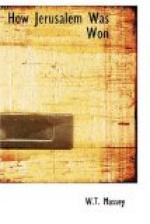and curtains which, in the dry heat of the summer,
wore very well. Looking across No Man’s
Land one could easily pick out a line of trenches
by a red, a vivid blue, or a saffron sandbag.
The Turkish dug-outs were most elaborate places of
security. The excavators had gone down into the
hard earth well beneath the deep strata of sand, and
they roofed these holes with six, eight, and sometimes
ten layers of palm logs. We had seen these beautiful
trees disappearing and had guessed the reason.
But an even greater protection than the devices of
military engineers had been provided for the Turks
by Dame Nature. Along the southern outskirts of
the town all the fields were enclosed by giant cactus
hedges, sometimes with stems as thick as a man’s
body and not infrequently rearing their strong limbs
and prickly leaves twenty feet above the ground.
The hedges were deep as well as high. They were
at once a screen for defending troops and a barrier
as impenetrable as the walls of a fortress. If
one line of cactus hedges had been cut through, infantry
would have found another and yet another to a depth
of nearly two miles, and as the whole of these thorny
enclosures were commanded by a few machine guns the
possibility of getting through was almost hopeless.
There were similar hedges on the eastern and western
sides of Gaza, but they were not quite so deep as
on the south. On the western side, and extending
south as far as the desert which the Army had crossed
with such steady, methodical, and one may also say
painful progression, was a wide belt of yellow sand,
sometimes settled down hard under the weight of heavy
winds, and in other places yielding to the pressure
of feet. The Turks had laboured hard in this mile
and a half width of sand, right down to the sea, to
protect their right flank. There was a point
about 4000 yards due west from the edge of the West
Town of Gaza which we called Sea Post. It was
the western extremity of the enemy’s exceedingly
intricate system of defences. The beach was below
the level of the Post. From Sea Post for about
1500 yards the Turkish front line ran to Rafa Redoubt.
There were wired-in entrenchments with strong points
here and there, and a series of communication trenches
and redoubts behind them for 3000 yards to Sheikh
Hasan, which was the port of Gaza, if you can so describe
an open roadstead with no landing facilities.
From Rafa Redoubt the contour of the sand dunes permitted
the enemy to construct an exceedingly strong line
running due south for 2000 yards, the strongest points
being named by us Zowaid trench, El Burj trench, Triangle
trench, Peach Orchard, and El Arish Redoubt, the nomenclature
being reminiscent of the trials of the troops in the
desert march. Behind this line there was many
a sunken passageway and shelter from gunfire, while
backing the whole system, and, for reasons I have
given, an element of defence as strong as the prepared
positions, were cactus hedges enclosing the West Town’s
gardens.




